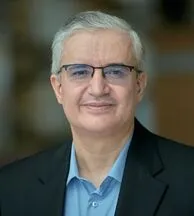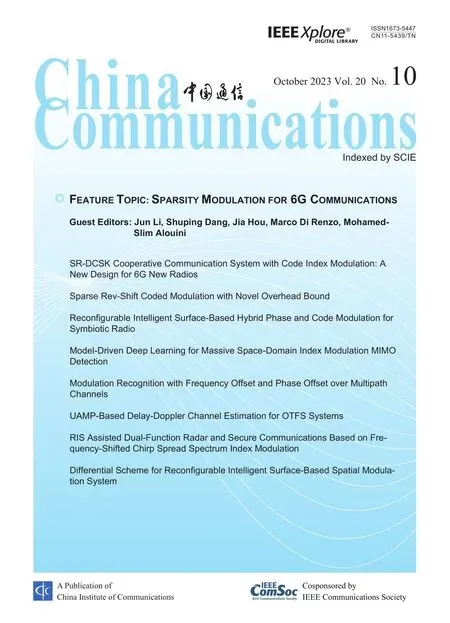Sparsity Modulation for 6G Communications
2023-11-06JunLi,ShupingDang,JiaHou等

Jun Li

Shuping Dang

Jia Hou

Mohamed-Slim Alouini
S parsity modulation is a promising technology for the sixth generation (6G) of communication networks,which satisfies the high requirements in terms of spectral efficiency (SE) and energy efficiency (EE).Currently,many representative sparsity modulation schemes,such as spatial modulation,index modulation,media-based modulation,reconfigurable intelligent surface (RIS)-based/reflecting modulation,and subcarrier number modulation,have attracted the attention of the wireless research community.Different from conventional amplitude-phase modulation schemes,sparsity modulation employs one or more modulation dimension(s) in addition to the conventional amplitude-phase constellation,so as to form higher-dimensional modulation schemes,which considerably enhance the SE at a reduced implementation complexity under proper system configurations.It is worth noting that the modulation dimensions in current sparsity modulation schemes are not fully explored due to limited resources.To address these challenges,communication researchers have concentrated on various aspects of their studies,including system model design,optimization of detection methods,performance analysis,practical implementation,and more.Nevertheless,given that this field is still relatively new,there remain numerous unresolved research questions.It is crucial to emphasize that further research efforts are essential to advance sparsity modulation from its current theoretical stage to practical implementation.
To address these challenges and enable practical implementations,this special issue is dedicated to offering in-depth insights into the advancements and developments in sparsity modulation,focusing on both theoretical and practical aspects encompassing system architecture,SE,EE,signal detection,physical security,artificial intelligence,resource allocation,optimization,and interference mitigation.The goal is to enhance the performance and practicality of sparsity modulation techniques while shedding light on future research avenues in this area.All submitted papers underwent a rigorous evaluation following China Communications’ standard review process.
Following rigorous and meticulous peer-review assessments,a total of eight papers have been accepted and included in this special issue.These selected papers delve into various aspects of sparsity modulation,exploring its relevance and applications within cooperative communications,channel estimation,modulation recognition,phase and code modulation,as well as secure communications in real-world network scenarios.Below,we provide a concise overview of each of these papers.Our aim is that this special issue will serve as a source of inspiration for future research endeavors in related fields.
With the explosive increase of data demand,how to improve the data rate of differential chaos shift keying cooperative communication (SR-DCSK-CC)systems is a challenge.In the paper titled SR-DCSK Cooperative Communication System with Code Index Modulation: A New Design for 6G New Radios,the authors propose a high-throughput SR-DCSK-CC system with the aid of coded index modulation.The system utilizes the code index modulation technique to assist a relay to transmit additional information.Specifically,the relay can incorporate its own information into the received signal from the source and send the combined information to the destination.Simulation results verify that the proposed system achieves significant improvements in terms of throughput over the conventional SR-DCSK-CC system without sacrificing bit error rate(BER) performance.
The encoding computation of shift-and-addition(SA) and zigzag decoding (ZD) is crucial for system feasibility in distributed modulation storage systems.In the paper titled Sparse Rev-Shift Coded Modulation with Novel Overhead Bound,the authors propose a sparse encoding method to design a sparse reverse shift combination property (CP)-ZD code,also known as Rev Shift.The corresponding Rev-Shift code,which has been proven to have CP-ZD properties,and a lower bound for storage costs has been derived for the first time.A series of simulations have verified a significant reduction in storage overhead,and the proposed lower bound is shown to be tight in certain scenarios.
Existing RIS aided symbiotic radio has encountered some challenges,such as the need to complex non-convex optimizations,the relatively poor error performance for the passive transmission,and the requirement of multiple receive antennas.In the paper titled Reconfigurable Intelligent Surface-Based Hybrid Phase and Code Modulation for Symbiotic Radio,the authors employ an RIS to simultaneously perform passive beamforming and direct sequence spread spectrum on the incident signals.By jointly using the phase shifts and spreading codes to convey passive information,a novel RIS-based modulation technique is proposed.The phase shifts are optimized in terms of both passive beamforming and information transmission.In addition to the optimal maximum-likelihood detector,a low-complexity yet near-optimal detector is designed.Upper bounds on the bit error rates are derived for both detectors over Rician fading channels.Extensive computer simulations verify the analysis and the performance superiority of the proposed scheme.
Multiple-input multiple-output (MIMO) is an important technology for future wireless communication systems,since it makes the most use of the resources in space,time,frequency,and polarization domains so as to greatly improve system spectrum and energy efficiency.In the paper titled Model-Driven Deep Learning for Massive Space-Domain Index Modulation MIMO Detection,a model-driven deep learning framework is exploited to overcome the challenge of multi-domain signal detection in space-domain index modulation (SDIM) based MIMO systems.Specifically,an improved orthogonal approximate message passing network (OAMPNet)is designed,and a novel signal recovery mechanism in the field of compressed sensing that effectively uses the sparse property from the training SDIM samples is proposed.In the paper,the authors first derive the prior probability of transmitting signals on each antenna for SDIM-MIMO systems.Then,for massive MIMO scenarios,two novel algorithms are designed to avoid pre-storing all active antenna combinations,thus considerably improving the memory efficiency and reducing the related overhead.
In general,the modulation recognition is usually unreliable in the low signal-to-noise ratio (SNR)region.In the paper titled Modulation Recognition with Frequency Offset and Phase Offset over Multipath Channels,the authors propose a strategy to identify the digital modulated signals with frequency and phase offsets in multi-path fading channels.The search for characteristic parameters is constructed based on the cyclostationarity of the received signals.Specifically,the carrier frequency of the received signal is first estimated,and the maximum characteristic parameter is then searched around the integer multiple carriers and their vicinities.Finally,the modulation types of the received signal with frequency and phase offsets are classified using decision thresholds to overcome phase offset,Gaussian white noise,and the influence caused by multi-path fading.Simulation results demonstrate that the performance of the proposed method is better than the traditional methods when the SNR is over 5 dB,and the proposed method is shown to be robust against frequency and phase offsets over multi-path channels.
Due to the low latency requirement in 6G networks,fractional Doppler shift must be taken into consideration,which reduces the sparsity of the effective channel and negatively impacts channel estimation performance.In the paper titled UAMP-Based Delay-Doppler Channel Estimation for OTFS Systems,the authors propose an efficient algorithm based on unitary approximate message passing(UAMP) to estimate the orthogonal time frequency space (OTFS) modulation channel in the presence of fractional Doppler.The proposed algorithm employs the hidden Markov model (HMM) to exploit the structured sparsity of the effective delay-Doppler domain channel and derives the belief propagation using a factor graph to determine a posteriori distribution of channel parameters.Simulations show that the performance of the proposed algorithm can approach the support-oracle bound closely while maintaining low computational complexity.
The rapid development of the Internet of Things(IoT) has led to rising demands for secure communications and intelligent perception in 6G communication networks.In the paper titled RIS Assisted Dual-Function Radar and Secure Communications Based on Frequency-Shifted Chirp Spread Spectrum Index Modulation,the authors propose a novel dual-function radar and secure communications(DFRSC) system,using the frequency-shifted chirp spread spectrum index modulation (FSCSS-IM)signal as the common baseband signal for both communication and radar modes.In the design of integrated sensing and communications (ISAC)system,the legitimate user’s azimuth information obtained by radar is utilized to support RIS aided beamforming,which can achieve collaboration between the DFRSC and RIS.Simulations show that the proposed system achieves good communication reliability and security.
The number of information matrices grows exponentially with the number of transmit antennas,resulting in high detection complexity especially for a large number of transmit antennas.In the paper titled Differential Scheme for Reconfigurable Intelligent Surface-Based Spatial Modulation System,the authors propose a differential scheme for RIS-spatial modulation (SM),which separates the detection of antenna index and the detection of modulated symbol so as to reduce the detection complexity.Unlike the differential reflecting modulation scheme,the incoming data bits of the RIS-differential SM scheme are mapped into receive antenna index and modulated symbol instead of information matrices,which improves the SE.
All in all,the Guest Editors of this special issue would like to express their sincere gratitude to all the authors for their valuable contributions and extend their appreciation to the anonymous reviewers for their insightful comments and recommendations.Additionally,the Guest Editors would like to recognize the Editor-in-Chief and the dedicated editorial team ofChinaCommunicationsfor their professional guidance and timely support throughout the entire process.
Biographies
Jun Li(Email: lijun52018@gzhu.edu.cn) received his B.S.degree from South Central University for Nationalities,Wuhan,China,in 2009,and the Ph.D.degree from Chonbuk National University,Jeonju,South Korea,in 2016.He is currently an Associate Professor with the School of Electronics and Communication Engineering at Guangzhou University,Guangzhou,China.He has published more than 60 papers in refereed journals and conference proceedings.He had participated in the World Class University (WCU) project,sponsored by the National Research Foundation (NRF) of Korea grant funded by the MEST as vice head researcher from 2009 to 2014 and Mid-career Researcher Program(Advanced research) through the Korean NRF grant funded by the MEST as head researcher from 2014 to 2017.He serves as a reviewer forIEEETransactionsonWireless Communications,IEEETransactionsonCommunications,IEEEJournalonSelectedAreasinCommunications,IEEE TransactionsonIntelligentTransportationSystems,andIEEETransactionsonVehicularTechnology.His research interests include spatial modulation,OFDM with index modulation,and reconfigurable intelligent surface.
Shuping Dang(Email: shuping.dang@bristol.ac.uk) received B.Eng (Hons) in Electrical and Electronic Engineering from the University of Manchester (with first class honors) and B.Eng in Electrical Engineering and Automation from Beijing Jiaotong University in 2014 via a joint ‘2+2’ dual-degree program.He also received D.Phil in Engineering Science from University of Oxford in 2018.Dr.Dang joined in the R&D Center,Huanan Communication Co.,Ltd.after graduating from University of Oxford and worked as a Postdoctoral Fellow with the Computer,Electrical and Mathematical Science and Engineering Division,King Abdullah University of Science and Technology (KAUST).He is currently a Lecturer with School of Electrical,Electronic and Mechanical Engineering,University of Bristol.The research interests of Dr.Dang include 6G communications,wireless communications,wireless security,and machine learning for communications.
Jia Hou(Email: houjia@suda.edu.cn) received his B.S.degree in Communication Engineering from Wuhan University of Technology in 2000,China,M.S.and Ph.D degrees in Information & Communication from Chonbuk National University,Korea,in 2002 and 2005,respectively.He was the post-doctoral research fellow and the invited professor in Chonbuk National University,Korea,from April 2005 to April 2007. And now he is the professor in Soochow University,Suzhou,China.His main research interests are signal processing,sequences,error coding,space time processing,wireless communications and networking.
Marco Di Renzo(Email: marco.di-renzo@universite-paris-saclay.fr) received the Laurea (cum laude) and Ph.D.degrees in electrical engineering from the University of L’Aquila,Italy,in 2003 and 2007,respectively,and the Habilitation à Diriger des Recherches (Doctor of Science) degree from University Paris-Sud (currently Paris-Saclay University),France,in 2013.Currently,he is a CNRS Research Director(Professor) and the Head of the Intelligent Physical Communications group in the Laboratory of Signals and Systems(L2S) at Paris-Saclay University– CNRS and CentraleSupelec,Paris,France.Also,he is an elected member of the L2S Board Council and a member of the L2S Management Committee.At Paris-Saclay University,he serves as the Coordinator of the Communications and Networks Research Area of the Laboratory of Excellence DigiCosme,as a Member of the Admission and Evaluation Committee of the Ph.D.School on Information and Communication Technologies,and as a Member of the Evaluation Committee of the Graduate School in Computer Science.He is a Founding Member and the Academic Vice Chair of the Industry Specification Group (ISG) on Reconfigurable Intelligent Surfaces(RIS) within the European Telecommunications Standards Institute (ETSI),where he serves as the Rapporteur for the work item on communication models,channel models,and evaluation methodologies.He is a Fellow of the IEEE,IET,and AAIA;an Ordinary Member of the European Academy of Sciences and Arts,an Ordinary Member of the Academia Europaea;and a Highly Cited Researcher.Also,he holds the 2023 France-Nokia Chair of Excellence in ICT,and was a Fulbright Fellow at City University of New York,USA,a Nokia Foundation Visiting Professor,and a Royal Academy of Engineering Distinguished Visiting Fellow.His recent research awards include the 2021 EURASIP Best Paper Award,the 2022 IEEE ComSoc Outstanding Paper Award,the 2022 Michel Monpetit Prize conferred by the French Academy of Sciences,the 2023 EURASIP Best Paper Award,the 2023 IEEE ICC Best Paper Award (wireless),the 2023 IEEE ComSoc Fred W.Ellersick Prize,the 2023 IEEE ComSoc Heinrich Hertz Award,and the 2023 IEEE VTS James Evans Avant Garde Award.He served as the Editor-in-Chief ofIEEECommunicationsLettersduring the period 2019-2023,and he is now serving in the Advisory Board.
Mohamed-Slim Alouini(Email: slim.alouini@kaust.edu.sa)was born in Tunis,Tunisia.He received the Ph.D.degree in Electrical Engineering from the California Institute of Technology (Caltech) in 1998.He served as a faculty member at the University of Minnesota then in the Texas A&M University at Qatar before joining in 2009 the King Abdullah University of Science and Technology (KAUST)where he is now the Al-Khawarizmi Distinguished Professor of Electrical and Computer Engineering.Prof.Alouini is a Fellow of the IEEE and OPTICA (Formerly the Optical Society of America (OSA)).He is currently particularly interested in addressing the technical challenges associated with the uneven distribution,access to,and use of information and communication technologies in rural,low-income,disaster,and/or hard-to-reach areas.
杂志排行
China Communications的其它文章
- Learning-Based Dynamic Connectivity Maintenance for UAV-Assisted D2D Multicast Communication
- AIGC Scenario Analysis and Research on Technology Roadmap of Internet Industry Application
- Dynamic Visible Light Positioning Based on Enhanced Visual Target Tracking
- Ultra Dense Satellite-Enabled 6G Networks: Resource Optimization and Interference Management
- Analysis and Optimization of Validation Procedure in Blockchain-Enhanced Wireless Resource Sharing and Transactions
- Anti-Jamming and Anti-Eavesdropping in A2G Communication System with Jittering UAV
